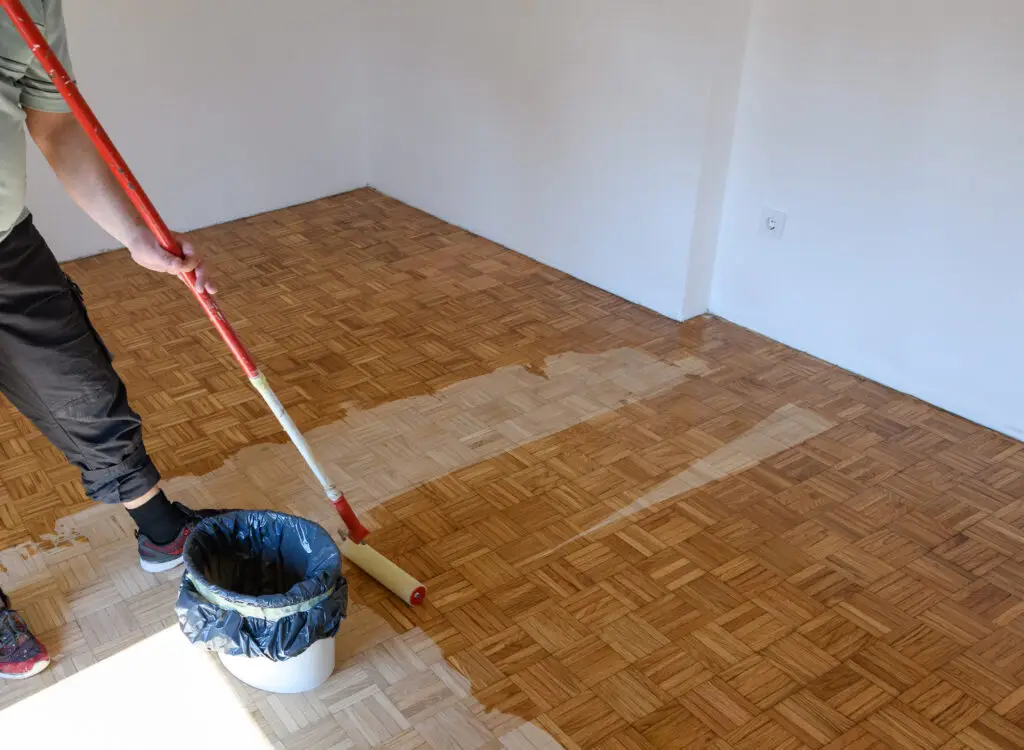Refinishing hardwood floors is an excellent way to restore their beauty and extend their lifespan. However, it’s a multi-step process that requires patience, especially when considering drying and curing times. Understanding the typical timeline involved can help you plan your project effectively, minimize disruption, and ensure a successful outcome. This guide will break down the factors that influence the duration of a hardwood floor refinishing project, provide a general timeline, and offer tips to help minimize downtime.

Factors that affect timeline
Several key variables can significantly impact how long it takes to refinish hardwood floors. Being aware of these will help you set realistic expectations for your project.
Size of the area
The most obvious factor is the square footage of the floors being refinished.
- Smaller Areas (e.g., a single room, hallway up to 200 sq ft): These projects can often be completed relatively quickly, with the hands-on work potentially finished in 1-2 days, followed by drying and curing.
- Medium-Sized Areas (e.g., a small apartment or 2-3 rooms, 200-800 sq ft): These will naturally take longer, typically requiring 2-4 days of active work.
- Larger Areas (e.g., an entire house, multiple levels, over 800 sq ft): Expect these projects to extend over 4-7 days or more for the active work, depending on the number of workers and the complexity.
More area means more time for preparation, sanding passes, cleaning, and applying multiple coats of finish.
Type of finish
The choice of finish is a major determinant of drying and curing times, which heavily influence the overall project length.
- Oil-Based Polyurethane:
- Drying Time: Each coat typically requires 12-24 hours to dry to the touch, making it the slowest option.
- Curing Time: Can take 30 days or even longer to fully cure and reach maximum hardness.
- Implication: Projects using oil-based polyurethane will have longer intervals between coats, extending the overall timeline and the period you need to stay off the floors.
- Water-Based Polyurethane:
- Drying Time: Much faster, typically 2-4 hours per coat. This allows for multiple coats in a single day.
- Curing Time: Generally takes 5-7 days to cure significantly, with full cure in about 2-3 weeks.
- Implication: Water-based finishes significantly reduce the active work time and the initial “no-traffic” period.
- Hardwax Oils/Penetrating Oils:
- Drying Time: Varies, but often similar to water-based (4-8 hours per coat). Some require only one or two coats.
- Curing Time: Can take 7-14 days to fully cure.
- Implication: These can offer a faster application time due to fewer coats but still require proper curing.
Drying and curing times
These are often underestimated but are crucial for the longevity and appearance of your floors.
- Drying Time: The period required for a coat of stain or finish to feel dry to the touch and be ready for the next coat or light foot traffic. This is influenced by humidity, temperature, and ventilation.
- Curing Time: The much longer period during which the finish hardens completely and achieves its full durability. During this phase, the finish is still vulnerable to scratches and dents, and placing rugs or heavy furniture too soon can cause issues.
- Ventilation: Proper ventilation is essential to accelerate drying times and safely dissipate fumes, especially with oil-based products.
- Humidity and Temperature: High humidity can significantly extend drying times, while low temperatures can also slow down the process. Ideal conditions are typically moderate temperature and low to moderate humidity.
Typical project timeline from start to finish
Here’s a generalized timeline for a professional refinishing project, assuming a medium-sized area (e.g., 500-700 sq ft) and professional equipment. DIY projects may take longer due to learning curves and less powerful equipment.
Day 1: Preparation and coarse sanding
- Morning:
- Room Preparation (1-3 hours): Moving furniture, removing rugs, clearing the area, setting nails, minor repairs, masking off adjacent rooms.
- Initial Setup: Bringing in equipment, setting up dust containment.
- Coarse Sanding (Drum and Edge Sander – 3-6 hours): First pass with coarse-grit sandpaper to remove old finish and deep imperfections.
- Afternoon:
- Cleaning: Thorough vacuuming after the first sanding pass.
- Medium Sanding (3-5 hours): Second pass with medium-grit sandpaper to smooth out coarse marks.
- Final Cleaning: Initial vacuuming.
Day 2: Fine sanding, final cleaning, and stain application (if applicable)
- Morning:
- Fine Sanding (2-4 hours): Final pass with fine-grit sandpaper to prepare the wood for staining or finishing.
- Meticulous Cleaning (2-4 hours): The most crucial cleaning phase. Multiple rounds of vacuuming, followed by wiping with tack cloths or microfiber cloths to remove all fine dust. Any dust left will be sealed into your finish.
- Afternoon (if staining):
- Stain Application (2-4 hours): Applying the wood stain, ensuring even coverage and wiping off excess.
- Stain Drying (Overnight): Allow 12-24 hours for stain to dry before applying the first coat of finish. This period can extend the timeline significantly if using oil-based stain.
Day 3: First coat of finish
- Morning:
- Light Sanding (Optional but Recommended – 1-2 hours): If stain was applied, or if using a water-based finish, a light buffing/screening with a fine grit might be done to smooth any raised grain. Followed by another meticulous cleaning.
- First Coat of Finish Application (2-4 hours): Applying the initial layer of chosen finish.
- Afternoon/Overnight:
- Drying Time: Allow the finish to dry according to the manufacturer’s instructions (e.g., 2-4 hours for water-based, 12-24 hours for oil-based).
Day 4: Second coat of finish
- Morning:
- Light Sanding (Optional – 1-2 hours): A light buffing/screening, followed by meticulous cleaning.
- Second Coat of Finish Application (2-4 hours): Applying the second layer of finish.
- Afternoon/Overnight:
- Drying Time: Allow the finish to dry.
Day 5 (and potentially day 6): Third coat of finish & initial light traffic
- Morning:
- Light Sanding (Optional – 1-2 hours): Another light buffing/screening and cleaning.
- Third Coat of Finish Application (2-4 hours): Applying the final layer of finish.
- Afternoon:
- Initial Light Foot Traffic: Floors may be ready for very light, sock-footed traffic after 24-48 hours from the final coat, depending on the finish type and environmental conditions.
Beyond day 5/6: Curing time
- Furniture Placement: Wait at least 72 hours (3 days) after the final coat before moving furniture back onto the floor, and use felt pads under all legs. For heavier items, wait longer if possible.
- Area Rugs: Avoid placing area rugs for at least 7-14 days (for water-based) or 30 days (for oil-based) to allow the finish to fully cure and off-gas without trapping moisture or chemicals.
- Full Cure: The finish will continue to harden for several weeks (2-3 weeks for water-based, 30 days or more for oil-based) until it reaches maximum durability. Be extra gentle during this period.
Total Active Work Time: Typically 3-5 days for a professional project, but can extend to 7 days or more for very large or complex jobs.
Total Downtime (Room Unusable): 3-7 days until light traffic is allowed.
Total Curing Time (for full durability): 1-4 weeks, during which careful use is advised.
Tips to minimize downtime
While some drying and curing times are unavoidable, you can take steps to make the process as efficient as possible.
- Choose a Fast-Drying Finish: Opt for water-based polyurethane or certain hardwax oils. These dry significantly faster, allowing multiple coats within a day and reducing the overall “off-limits” period for your floors.
- Optimize Environmental Conditions:
- Ventilation: Ensure excellent airflow by opening windows and using fans to draw air out of the room. This helps speed up drying.
- Temperature and Humidity: Aim for moderate temperatures (65-75°F or 18-24°C) and low to moderate humidity (40-60%) for optimal drying. Avoid refinishing on very humid or cold days.
- Refinish During Off-Peak Times: If possible, schedule the project during a time when you can easily vacate the area, such as during a vacation or when children/pets can stay elsewhere. This minimizes disruption.
- Work in Stages (if possible): If you’re refinishing multiple rooms or levels, consider doing them in sections. This allows you to have some usable living space while other areas are drying or curing. For example, refinish bedrooms first, then living areas.
- Hire Professionals: Experienced flooring contractors have specialized, more powerful equipment that can expedite the sanding process. They are also skilled in efficient application techniques, which can significantly reduce active work time compared to a DIY approach.
- Clear the Area Completely: Before the project even begins, ensure the entire area is empty. This saves the contractor (or yourself) valuable time on the first day.
- Plan for Furniture and Foot Traffic: Know exactly where furniture will be stored and what routes you (and your family/pets) will take during the project. This prevents accidental contact with wet finishes.
By understanding the factors influencing the timeline and implementing these tips, you can better manage your hardwood floor refinishing project, ensuring a beautiful result with minimal inconvenience.
